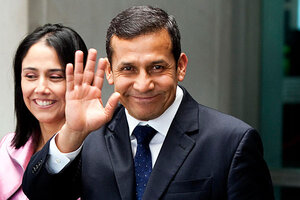Peru swears in new president: Who is Ollanta Humala?
Peru's new President Ollanta Humala is a former Army officer who once led a rebellion. He faces the task of maintaining rapid economic growth while diffusing growing social unrest.

Peruvian President-elect Ollanta Humala waves as he walks from the State Department after meeting with US Secretary of State Hillary Clinton in Washington, July 6. At left is Humala's wife Nadine Heredia.
Joshua Roberts/Reuters/File
Lima, Peru
Peru’s new president, Ollanta Humala, takes office today and may need all the skills of his Inca warrior namesake to juggle multiple social demands while maintaining this Andean country’s rapid economic expansion.
Mr. Humala begins his five-year term amid one of the longest economic expansions in the country’s history. Peru's gross domestic product has risen at an average rate of 7.2 percent annually, according to the UN Economic Commission for Latin America and the Caribbean (ECLAC), with the highest growth over the past five years. The economy grew by 8 percent in the first five months of this year alone.
This flood of cash could come to a screeching halt if the Humala administration does not find a balance between his many campaign promises of social inclusion, including new welfare programs and dealing with ongoing social conflicts, and keeping the economy strong.
While inflation is negligible and exports are booming, the government agency that safeguards citizen rights catalogued 217 social conflicts in June, 105 of which saw at least one violent incident. More than 100 protesters have been killed in clashes with police officers in the past few years, nine alone in two protests in the highlands in June.
More than half of the conflicts are environmental in nature and aimed at the heart of the economic motor – mining and oil or gas projects. The Energy and Mines Ministry forecasts $42.5 billion in investment in mining projects in the coming five years. Another $15 billion should be added by energy projects.
“It is not going to be easy for the new government to deal with conflicts. It will take time to tackle the cause of these conflicts,” says Jose de Echave, a director of the nongovernment group CooperAccion.
Humala has decided that this can be done with an 18-member Cabinet that spans Peru’s political spectrum. Several ministers, including Foreign Minister Rafael Roncagliolo, come from a solid left-wing tradition, while Harvard- and Johns Hopkins-educated Finance Minister Luis Miguel Castilla is an orthodox economist. There are also a few nonpolitical picks, such as Susana Baca, a Latin Grammy-winning singer, who is the first Afro-Peruvian woman to form part of the executive branch.
Luis Benavente, a political science professor at the University of Lima, said Humala is trying to emulate Brazil’s former president, Luiz Inacio Lula da Silva, “following a conservative economic plan while trying to improve the standing of the country’s poorest sectors with more leftist social policies. The left is going to have to accept the fact that it will not run the economy.”
The cabinet looks, in some ways, like Humala’s own varied political positions throughout his long march to the presidential palace.
A retired Army officer, Humala shot to fame in October 2000, when he and a younger brother began a small military rebellion in the south of the country with the goal of toppling then-embattled former President Alberto Fujimori. Humala was briefly jailed and was in the process of being court-martialed. Instead, he was reinstated into the Army after Fujimori fled Peru and the presidency. Fujimori, meanwhile, is now in jail, serving a 25-year sentence for crimes committed during his 10-year rule (1990-2000).
Humala launched his first presidential bid in the 2006, making it to a runoff but lost to Alan García. He came in first in April in a field of 11 candidates, but again entered a runoff. He narrowly defeated Congresswoman Keiko Fujimori, the jailed president’s daughter, on June 5.
Humala ran in 2006 on a strong left-wing platform, embracing Venezuelan President Hugo Chávez’s “21st century socialism.” His original platform for this race was also strongly left wing, but that changed as the campaign advanced. Mr. Da Silva replaced Mr. Chávez as Humala's mentor, causing the president to move toward the center. The centrist move helped quiet his media critics, who were largely anti-Humala in the election.
Humala will face some difficulty with Peru's Congress, where his party has only 47 of the 130 seats. He will need to form an alliance with former President Alejandro Toledo’s party, which has 21 seats, to achieve much of his agenda. Raising the minimum wage by 20 percent and creating several new social programs, including a national daycare program and pension system for senior citizens with no coverage, will require the votes of other parties.
There is also the issue of Humala's family. One brother, Antauro, in is prison for trying his own rebellion, this time against former President Toledo in 2005. Four police officers were killed.
Another brother, Ulises, the oldest of the seven Humala siblings, also ran for president in 2006. He is a staunch political enemy of the new president. Sibling number five, Alexis, caused uproar in early July by traveling to Russia under the guise of “special envoy” of the president-elect. Humala said he did not know about the trip, and the brother apologized. Still, after the incident, Humala’s popularity in one public opinion poll dropped from 70 percent in June to 41 percent in July.
The incoming government knows it will be tough going.
“There are solutions to the many issues facing the country, but we have to be proactive and not wait until problems become crises. Five years is not a long time, but we can set the course of a more equitable society,” says Ricardo Giesecke, the new environment minister.
